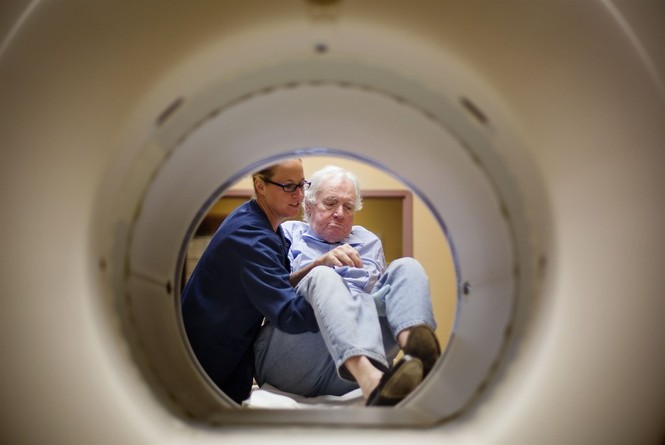On May 10, listening to Beethoven's 9th Symphony, 104-year-old David Goodall moved on from this world to the next. But there is something unique and noteworthy about Goodall's passing. Goodall, even at his ripe old age, was a healthy gentleman. His death wasn't due to body failure or to him succumbing to any type of debilitating brain disease or aggressive form of cancer. He wasn't in pain, and he wasn't suffering. Goodall, as he told the BBC, was "happy." The man whose life surpassed the century mark died after seeking out physician assistance with his suicide.
Goodall left his home to die in Switzerland, though he wished he could have spent his last moments in Australia. While physician-assisted suicide is still illegal in Australia, Switzerland has allowed it since 1942. Goodall's story has reopened the discussion over physician-assisted suicide and euthanasia; because when one thinks of the hotly debated topic, it typically revolves around patients who are terminally ill or experiencing significant amounts of pain and suffering, not patients who want to die because they believe they have lived long enough.

Hitting Home
In the United States, six states - including Oregon, Washington, California, Vermont, Colorado, and Hawaii - as well as Washington, D.C., legalized physician-assisted suicide through legislation. Montana legalized physician-assisted suicide thanks to a court ruling. However, the laws on the books only apply to patients who are terminally ill. In all places where physician-assisted suicide is legal, except Montana, patients must be 18 years of age and must have received a terminal diagnosis stating they have six months or less to live.
Over the last few years, Americans have heard several stories of patients choosing physician-assisted suicide when facing terminal diagnoses. In 2014, the story of Brittany Maynard, a young, 29-year-old woman suffering from a terminal brain tumor, made headlines as she decided to end her own life under Oregon's "Death With Dignity Act."
Recommended
But what does this all mean for our society? Should these sorts of practices be allowed to proliferate? Does it indeed bring dignity to those who want to die, or is it a slippery slope towards a disregard for life?
Before addressing the points on each side, one must note the difference between physician-assisted suicide and euthanasia. Physician-assisted suicide is when a physician prescribes life-ending medication to a patient who then takes it on their own accord. Euthanasia is when a doctor is directly involved in ending the patient's life - for example, directly putting life-ending medication into the patient's IV.

Opponents
1. There Are Solutions to Pain, and We Have Palliative Care or Hospices
While proponents say patients should be able to take their lives to prevent physical suffering, medical technology and modern medicine have allowed patients to be relieved of such pain. Rather than allowing patients to take their lives, opponents say patients can be made as comfortable as possible.
In 2016, The Washington Post wrote an article stating that researchers have found that people aren't taking their lives because of the pain, but rather because they want to control how they die.
Yet the latest research shows that terminally ill patients who seek aid in dying aren’t primarily concerned about pain. Those who have actually used these laws have been far more concerned about controlling the way they exit the world than about controlling pain.
The research suggests that patients’ motivations are more complicated than they’re often portrayed and could affect how people vote on the issue in other cities and states.
One physician interviewed by The Washington Post, Ira Byock, "who specializes in palliative care," said, "It’s a bait-and-switch. We’re actually helping people hasten their deaths because of existential suffering. That’s chilling to me." She went on to add that "we can relieve the suffering of almost everyone that we care for if we have the time to prepare."
While opponents use this point to push back against pain as a legitimate justification, it doesn't necessarily address the argument of "bodily autonomy."
2. Physician-Assisted Suicide Creates a Slippery Slope
The slippery slope refers to a controversial idea becoming acceptable and eventually leading to other decisions that are wrong and ultimately disastrous. For example, opponents argue that the legalization of physician-assisted suicide for terminally ill patients will lead to the death of people who are not terminally ill, but who may be dealing with other ailments or mental illnesses that are treatable.
Over at National Review, Wesley J. Smith, an author and a senior fellow at the Discovery Institute’s Center on Human Exceptionalism, wrote an article addressing the "inexorable expansion" of physician-assisted suicide and illustrated numerous abuses by countries overseas.
For example, in the Netherlands, Smith writes:
Killable people now range from the terminally ill and the chronically ill, such as a woman with serious tinnitus, to people with disabilities, such as people with paralysis and chronic alcoholics, dementia patients who ask to be euthanized in advance directives, the elderly with non-life-threatening health concerns or early dementia — and even 83 mentally ill patients in 2017.
Smith also details a horrifying case where a woman who was suffering from dementia, who had also stated that she never wanted to end up in a nursing home, was put in one anyway, and her doctor eventually decided that it was time for the woman to die. Smith cites the report from the Daily Mail, which details how the doctor first drugged the woman's coffee to sedate her. But while the doctor was starting the lethal injection, the woman woke up and begged for her life. It didn't save her anyway.
Smith lists other abuses of physician-assisted suicide, as well.
There have been many clear cases of abuse: the elderly woman euthanized for macular degeneration, the anorexic young woman put down because of the suffering she experienced from her eating disorder, the nursing-home doctor who euthanized a patient he thought had lung cancer before the diagnosis was confirmed.
Though these cases have not happened in the U.S., opponents worry that there will be nothing to prevent them from occurring here if physician-assisted suicide is normalized.
3. Physician-Assisted Suicide Puts Doctors in a Tough Position
While people focus on the patient in these cases, what about the doctor? What if a doctor wants to uphold the value of the patient as a human being and believes that all life has value and should not be recklessly taken? What if they want to uphold their view of the Hippocratic Oath, which in part states, "I will neither give a deadly drug to anybody who asked for it nor will I make a suggestion to this effect..."
Though patients can refuse care - like former First Lady Barabara Bush did days before she passed away - would doctors be forced to grant requests that they know brings harm to the person requesting it?
Proponents
1. It's the Patient's Body; They Have Bodily Autonomy
Supporters of physician-assisted suicide and euthanasia often argue that terminally ill patients have the right to die with dignity, referring to the idea that every individual has the right to choose how, and when, they die. Similar to the argument made by those who are pro-choice regarding abortion rights, supporters of physician-assisted suicide and euthanasia state that the person has the right to determine what happens with their body. If they want to end their life, they should be able to do so, whether the pain they are experiencing is an influencer in their decision or not. The notion is that the will of the person should trump everything else.
2. Physician-Assisted Suicide and Euthanasia Are Compassionate
Physician-assisted suicide and euthanasia are not only about bodily autonomy for proponents. Proponents also take a position that says such policies are compassionate, which goes hand-in-hand with bodily autonomy. They believe it is wrong and immoral for patients to be forced to suffer through unbearable pain or an incurable disease. It would be an act of compassion to allow a patient to take their life, so they would not experience suffering.
Why prolong a patient's suffering when there is no cure? If a patient receives a terminal diagnosis, proponents argue, and they are determined to be mentally competent, they should have the right to have a physician prescribe them a lethal dose of medication or have the physician administer a lethal injection to end their suffering.
3. Physician-Assisted Suicide and Euthanasia Can Be Regulated
Opponents of implementing physician-assisted suicide and euthanasia state that allowing doctors to take the lives of willing patients will lead to a slippery slope. However, proponents argue that the government can effectively regulate this practice by setting strict guidelines on who does and does not qualify for physician-assisted suicide. For that reason, states that allow physician-assisted suicide require the individual to be at least 18 years of age and mentally competent, as the person must be a legal adult and of sound mind when making their decision. Furthermore, they must be diagnosed with a terminal illness and given six months or less to live. At that point, the patient is said to have the right to end their life.

You Decide
There are other positions for and against physician-assisted suicide, but those above are some of the most popular used to argue for or against such policies. With the death of David Goodall, the conversation surrounding physician-assisted suicide has spiked. States across the country are trying to legalize the policies with varying amounts of success. While Hawaii legalized physician-assisted suicide in April 2018, Delaware failed to get the votes necessary to pass its state House, and California just had its law allowing physician-assisted suicide overturned by a judge due to a technicality.
Where do you stand on the issue?

























Join the conversation as a VIP Member